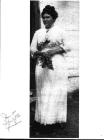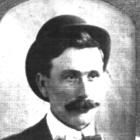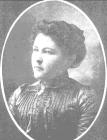1
The Huble FamilyIn 1865 two years after John Giscome reported on his famous trip across Lhedesti, the shortcut across the Continental Divide that is now known as the Giscome Portage, Samuel Huble (1843-1911) married Nancy Ann Drain (1848-1928) they had 4 sons and 7 daughters. One of their sons Albert James Huble, along with his partner Ed Seebach, began the successful trading post and Homestead at the south end of the Giscome Portage.
Al was from Ontario but he eventually found his way west and began his trading business in 1904. in 1911 he was visiting Ontario and he met and married Ann May Hart (Annie). Annie had been married before to a Mr. Copperthwaite and had three children, Adelaide (Ada), Lillian and Harry.
Al brought Annie and Ada back to Giscome Portage and built a fine home there. The couple had 7 children of their own: Bertha Bernice(1911), Martha Marian (1913), and Frances Patricia (1914), Gladys May (1916) Albert James Jr. (1918), Samual Edward (1921) and Dean Richard (1930?).
2
Huble family outing with Al Huble holding Sam, and Annie Huble behind him.1923
Summit Lake, British Columbia, Canada
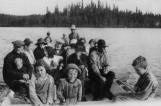
3
The Huble FamilyThe photo shows a special outing with many friends and family it was taken about 1923.
At left Al Huble is holding Sam, Annie Huble behind him, Pat in front, Bertha in sailor blouse behind Pat. Young Al Huble Jr. sitting in the centre front
5
Albert James HubleAudio:
Al Huble jr. Taped Interview
"They bought a schooner, a fishing schooner, they were gonna go and fish and they had about the first trip out, they were all green horns and got in the middle of a storm. When they got ashore he was trying to --------------- They'd heard all the stories about what was going on out West. Young guys ---------- he was up logging in the Columbia River country. Those, there was quite a bit of logging and I met some, the Otto(?) brothers, they're settled in Jasper. They were young guys logging up there on the Columbia ------- and Joe came on the Fraser, up the canoe river and down the Fraser at Tete Jeune ------- a short portage around Valemont. Quite a few people come into this country that way, by canoe off the Columbia River and then down the Fraser. Joe -------- I guess dad was in there ---- fishing in ------ then went to the gold rush but he hikes out and ------- crossed the head waters and ------ around the Liard and came out, let's see, the Stikine. Stayed around there "
Albert James Huble:
Albert James Huble was born at Oak Lake, Ontario on September 4, 1872. He was the fourth child in a family of seven daughters and four sons. At age thirteen, he left home and moved to Chicago, where he spent the next five years. It is not known what Al did for the next while; however, around 1891 he went west to work on the construction of the Canadian Pacific Railway in British Columbia in the Kootenay area. Following this, he headed off to the Yukon Gold Rush. On route, he stopped by Hazelton, at the confluence of the Skeena and Bulkley Rivers. There he met a man named George Burns. He and George became partners and they headed over the Telegraph Trail towards Atlin in northwestern B.C. to find their fortune in gold. While in the Atlin area they tried trapping. The two found trapping paid very well, so they gave up the notion of finding gold. However, three years later, they found they wanted to try something different so they bought a ship for fishing over near Wrangell, Alaska. The two had no experience in fishing in ocean waters so they almost drowned. Following that, Al tried his hand working at a barber-shop back in the Hazelton area, where he worked for a few years. In 1904, he began a partnership with Ed Seebach in the Fort George area. During the winter of 1903/04, they ran trap lines, just north of the big bend on the Fraser River. In 1904, the two established a fur trading post on the Fraser River at the south end of Giscome Portage. Al Huble settled in and pre-empted land there in November of 1905. Al Huble Jr., felt that his father, Albert, was "an adventurous soul".
Albert Huble was an entrepreneur. He and his partner Edward Seebach, created a chain of three warehouses and stores from the homestead at the south end of Giscome Portage, all the way to McLeod Lake (including the one at Summit Lake). Additionally, he trapped, bought, sold and traded furs, hauled freight and transported people over the portage, he surveyed land and guided river travelers through the Giscome Rapids and ran a roadhouse (of sorts) at the Huble family home. Al wrote a speech in his diary of 1915, it went like this.
"No one will deny the demoralization of any useful industry is in economic waste. A bad thing for the public at large and that its stayability [sic] based on a sure but moderate profit is the ideal condition for the consumer as well as for those directly or indirectly connected with its activities.
Wreckage always means waste and financial wreckage is no exception to the rule. A few individuals may secure a momentary benefit from an industrial failure but to society at large it invariably involves a final net loss. Labor suffers, investment suffers, and the body of business in general is disordered.
The modern association spirit is a good one. You can't beat it. Sneaking trade secrets and trying to throttle the man who happens to be your competitor belong to the dark ages of industrial competition. To the period of federalism the associations are now driven out of business. I would hate to think of any line being without an association. Instead of continually reacting for one another's throat we are doing something for the good of the line and everybody in it."
Whether Al Huble wrote this speech or not, and it is believed that he did, the speech undoubtedly speaks of his business ideals.
Al Jr. said that his father "was a one drink guy and two would be a great occasion". He also said that his dad smoked a pipe, "but not those cigarettes." He said, his dad would describe a guy with a cigarette in his mouth as, "a cigarette hanging down his lip like a porcupine quill in a dog's mouth."
According to Al Jr., Christmas time was special too. He told this story.
"He came down to the portage from the McGregor one year. He got there December 22nd and the next morning he took off breaking trail to Fort George, down there 45 miles with a toboggan. Christmas Eve, he was back home with the toboggan and all the goodies for Christmas. He must have been tough, I don't know. He'd buy things, he loved oysters, he'd get them little wooden kegs of oysters and a half a beef; whatever was available."
7
Martha (Al and Annie Huble's second daughter) remembered her dad as a "multi-faceted man", who could do many things. She told this story about her father."He found a baby moose and brought it home and they raised it with a bottle. When it got older, they made a harness for him and he pulled the children on a sleigh, just like a horse. It also used to open the screen door with its hoof and go into the house. They would have to open the door, on the other side of the house and let it wind its way through the house and out the other side."
The Huble children have told many other stories about their father Al as well. Al Huble Jr. liked to talk about Christmas time with his dad. He said his dad would walk the forty-one miles through the northern forests into Fort George to buy Christmas goodies for the family. Al Jr. felt his father was a real family man.
8
Al Huble and his dog.1910
Huble Homestead/Giscome Portage on the Fraser River, North of Prince George, British Columbia, Canada
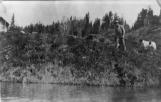
9
The building to the far left of the picture is a cabin where Al lived before he was married to his wife Annie. This building was later moved to the back of the new (1912) house were it was used as a kitchen for the new family home. The root cellar can also be seen in this picture and is directly to the left of Al. Al was likely walking down to the river to meet a boat carrying passengers and freight.In this picture Albert Huble is walking his dog down by the river at the Giscome Portage in the year (circa) 1910. The dog with Al in this picture could be the dog that helped save his life during a brawl with a grizzly.
10
The year is (circa) 1912 and Al is out on the trap line checking his traps.1912
Fraser-Fort George Region, Prince George Area British Columbia, Canada
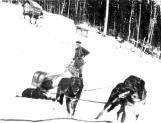
11
The year is (circa) 1912 and Al is out on the trap line checking his traps. It is a relatively warm winter day, the sun is shining and the dogs have just had a hard trip through the snow. Al is standing beside a food cache and a small log storage building where he stores a food supply, furs and other essential winter supplies. His trapper's cabin where he stays on cold winter nights is not shown here. The sled dogs are wearing homemade leather harnesses and the sled he uses is called a toboggan sled used for hauling heavy loads of freight and furs. Both Al Huble and Ed Seebach had trap lines in the vicinity of the Giscome Portage. Two creeks, which were within their trapping area, are now named after each of these men.13
Ann May HartAnn May Hart was born in 1882 and lived in Havelock, Ontario when Al Huble courted her in the winter of 1910/1911. Ann (Annie), was previously married, with three children, Adelaide Marion (Ada), Lillian and Harry, before her marriage to Albert James Huble (Al). When Al went back to Ontario in 1910 for Christmas, he stayed for a number of months. In March he purchased an extra ticket on the train to Ashcroft, B.C. for his new wife. Al and Annie arrived in Ashcroft B.C. on the train on March 15th 1911. Al and Annie had their first common child, Bertha Bernice on October 17, 1911.
Over the next 20 years, Annie had six more children with Al, three more girls and following, three boys. A typical day for Annie, according to Al Huble Jr., was to rise at 6:00 a.m. and prepare and serve breakfast for the family and any traveling house guests. Following that, Annie cleaned-up the dishes, washed the laundry, prepared lunch, cleaned-up and washed lunch dishes, took in the previous day's laundry from the clothesline and hung out the new clean laundry. After this Annie ironed, with an iron heated on the wood cook stove. While doing all of these chores, she took care of all the children, including babies. In the late afternoon, Annie also gardened or cleaned the family home. In the evening, she prepared dinner for the family, and often, large groups of travelers, or visitors, following which she again cleaned up and washed dishes.
The Huble Homestead was a much like a Cariboo roadhouse; however, rather than being literally on the Cariboo Road, it was a stop along a lengthy series of watercourses. This watercourse route connected the Omineca gold fields and Peace River Valley with the rest of B.C. Therefore, the Huble home was more than just a busy family home, which Annie had to look after, it was also a busy roadhouse.
Annie raised her large family, grew and preserved most of the family food and made most of the family's clothing on top of being an innkeeper. After the children were in bed, Annie would knit or sew the children's clothing, or do quilting.
14
Annie Huble in front of the Huble House at the Homestead at Giscome Portage, 1919.1919
Huble Homestead/Giscome Portage on the Fraser River, North of Prince George, British Columbia, Canada
